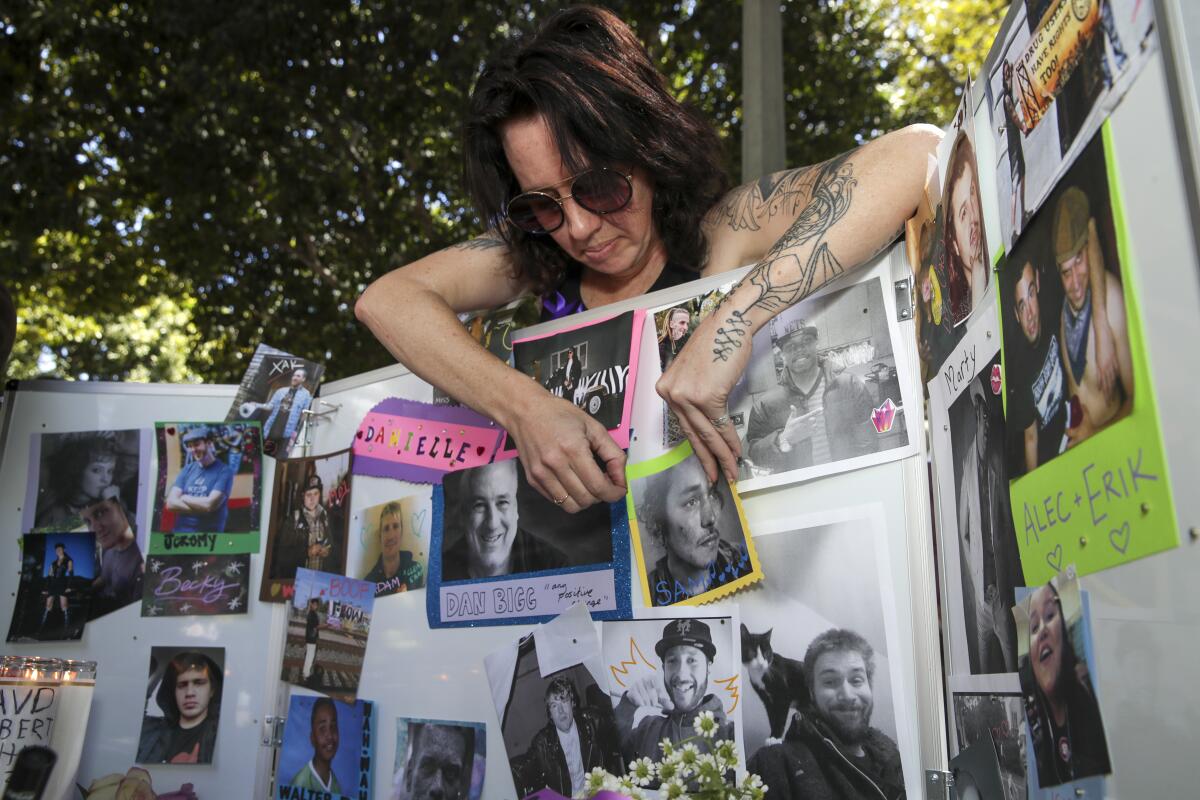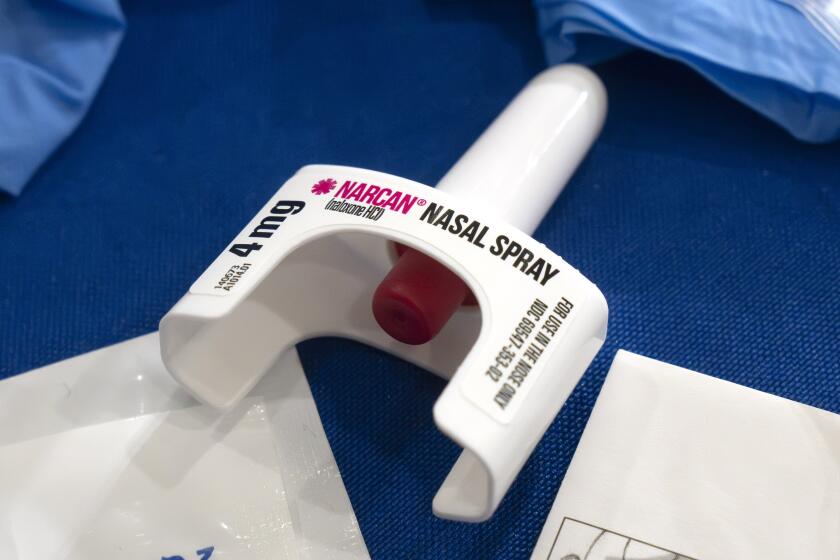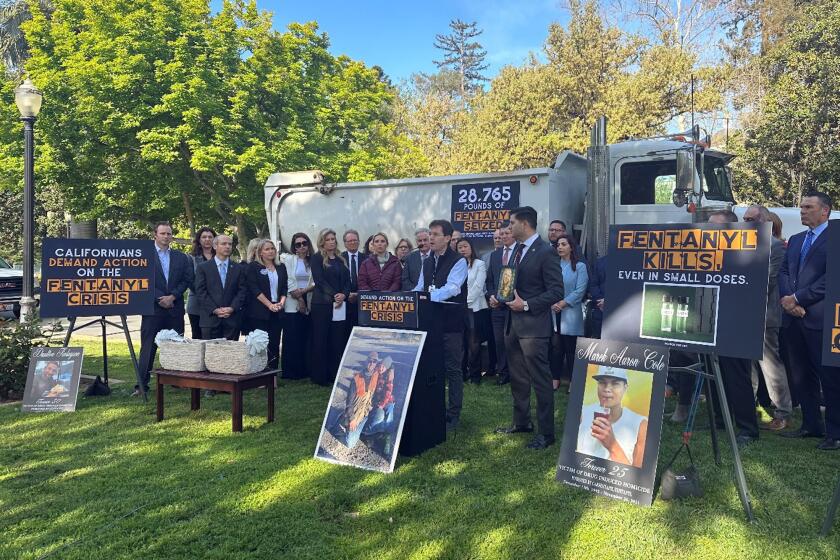Fentanyl overdoses contribute to surge in L.A. County homeless deaths

- Share via
A devastating surge in drug overdoses drove up deaths among unhoused people in Los Angeles County in recent years, along with the rising toll of traffic collisions and homicides, according to a public health department report released Friday.
The death rate increased 55% among people experiencing homelessness in L.A. County between 2019 and 2021, a markedly sharper increase than in the years before the COVID-19 pandemic, public health officials found.
More than 2,200 unhoused people died across the county in 2021 — the first time the agency has reported an annual toll exceeding 2,000, said Will Nicholas, director of the Center for Health Impact Evaluation at the L.A. County Department of Public Health.
The bottom line is that “it’s becoming more deadly or dangerous to be homeless,” Nicholas said.
The leading cause of death was drug overdoses, which made up more than a third of deaths among homeless people in L.A. County in 2020 and 2021 combined, the report found.
Deadly overdoses often involved more than one drug, but the surging rate of overdose deaths appears to be tied to the explosive rise of fentanyl, public health officials said. The powerful synthetic opioid was implicated in 58% of deadly overdoses among unhoused people in L.A. County in 2021 — nearly three times the percentage that had involved fentanyl in 2019.
A free vending machine that dispenses the overdose-reversal drug naloxone was unveiled this week at Santa Clara University, the first such campus resource in the Bay Area.
Methamphetamine, in turn, was involved in nearly 77% of the overdose deaths. That figure, which had risen in recent years, was slightly higher among unhoused women than unhoused men, possibly because some women use meth to try to stay awake and avoid sexual assault on the street, the county report noted.
Nicholas said that people who overdosed solely on meth tended to be “considerably older,” making them more vulnerable to health risks from stimulant use.
Both meth and fentanyl have been mingled with other drugs to deadly effect. More than 40% of overdose deaths among homeless people involved both fentanyl and methamphetamine in 2021, the county report found. Fentanyl deaths “almost always involved other drugs as well,” but the public health department said it could not determine from the data whether people were using fentanyl on purpose or unknowingly.
“It’s just so hard to see people literally dying in the street when it doesn’t have to happen,” said Theo Krzywicki, chief executive of the nonprofit End Overdose.
Krzywicki, who also works as an L.A. city firefighter and paramedic, said that overdose calls have become alarmingly routine for his unit. As the pandemic began, his nonprofit also saw swelling demand for naloxone, a medication that can pull someone out of an opioid overdose.
“We regularly go through a few thousand doses a month,” he said.
Fentanyl overdoses have skyrocketed in general in L.A. County, but the overdose crisis has hit unhoused people especially hard. Homeless people in the county were nearly 39 times more likely to die of drug overdoses than the general population, the report found.
The numbers underscore “the urgency of the overdose crisis, which is the worst in history” both locally and nationally, “as well as the fact that this is significantly impacting some of the most vulnerable members of our society,” said Dr. Gary Tsai, director of the substance abuse prevention and control division in the public health department.
Tsai said the crisis has been particularly pronounced for unhoused people because of their higher rates of substance use disorder and mental health conditions, which increase the likelihood of drug use. And “people oftentimes will turn to drugs for some form of connection, or because of how disconnected they are from things that are important in life,” he said.
What makes that even riskier, he said, is that many unhoused people are isolated, and using drugs alone ramps up their risk of dying from an overdose because there is no one there to intervene or call for help.
Meghan Hynes, an outreach volunteer and board member with the Sidewalk Project, which works in Skid Row, said she often urges people who are going to use drugs to let someone know beforehand.
Hynes said that people living on the street are also at higher risk of overdose because “you sometimes don’t have the luxury of deciding, ‘This batch seems better to me or safer to me’” when obtaining drugs. Checking for fentanyl with test strips can help, but “ideally you need water,” which can be impractical on the street, she said.
The public health department calculated mortality rates per 100,000 people by comparing annual deaths among unhoused people to the total unhoused population in the county. To accurately compare mortality rates between groups of homeless people, it adjusted for age differences in their populations.
Among the unhoused population in L.A. County, the rates of overdose deaths have been highest — and continued to climb — among white people and those in their 50s and 60s. Homeless men are also dying of overdose at higher rates than women, the county report found.
The second-leading cause of death among people experiencing homelessness was coronary heart disease, which made up 14% of deaths among unhoused people in L.A. County in 2020 and 2021, followed by traffic injuries, which accounted for 8% of deaths. The fourth-leading killer of homeless people was homicide, the rate of which saw an unnerving increase of 49% between 2020 and 2021.
All in all, homeless people were dying at nearly four times the rate of the L.A. County general population during 2020 and 2021 combined, when adjusted for age and gender differences in the population.
At a Thursday hearing, state lawmakers advanced four bills, including one that would increase penalties for fentanyl dealers.
That gap had widened since before the pandemic, partly due to a growing disparity in traffic-related deaths between housed and unhoused people, the report found. COVID-19 also killed homeless people at a higher rate than housed people in L.A. County.
“Being unhoused puts you at such a greater risk for mortality than the general population. It’s not just overdoses,” but also other health threats such as food insecurity that disproportionately affect unhoused people, said Sarah E. Clingan, an assistant project scientist at UCLA Integrated Substance Abuse Programs.
To save lives, the L.A. County Public Health Department argued that many changes are needed, including ramping up the distribution of naloxone, commonly known under the brand name Narcan; improving access to medications such as methadone and buprenorphine that help people shake off addiction; expanding mobile clinics for unsheltered people; and moving forward with supervised sites where people can consume drugs so that trained staff can intervene and stop overdoses.
Last year, Gov. Gavin Newsom vetoed a state bill to launch such supervised sites in Los Angeles, San Francisco and Oakland, although the governor said he remained open to the idea if local officials returned to the California Legislature with “comprehensive plans.” Tsai said that in L.A. County, discussions are underway with law enforcement and other local officials.
Krzywicki, of End Overdose, said “we need more naloxone. We need more people down there really doing this outreach.” And for homeless people, “you need to be able to put somebody in a safe and secure place where you can then provide them services.”
Hynes, with the Sidewalk Project, said the latest numbers left her feeling “a little despondent.”
“It is hard to see that we keep passing by all of these really viable, really effective options” such as overdose prevention sites, Hynes said. “We’re really allowing this to happen. ... It’s tragic and it’s heartbreaking and sometimes it’s hard to be hopeful.
“But we’ve got to keep doing the work,” she said.
More to Read
Sign up for Essential California
The most important California stories and recommendations in your inbox every morning.
You may occasionally receive promotional content from the Los Angeles Times.
















